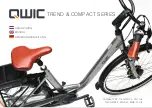
10
f)
Mechanical safety check
Check the condition of your bicycle before every ride.
Nuts, bolts and straps:
Make sure nothing is loose. Lift the front wheel off the ground by two or three
inches then let it bounce on the ground. Anything sound, feel or look loose? Do a quick visual and tactile
inspection of the whole bike. Are there any
loose parts or accessories? If so, secure them. If you’re not
sure, ask someone with bike experience to check.
Tires and Wheels:
Make sure tires are correctly inflated, see Chapter 6. Check by putting one hand on the
saddle, and the other on the intersection of the handlebars and stem, then bounce your weight on the bike
while looking at tire deflection. Compare what you see with how it looks when you know the tires are
correctly inflated; and adjust if necessary. Are the tires in good shape? Spin each wheel slowly and look for
cuts in the tread and sidewall. Replace damaged tires before riding the bike. Spin each wheel and check for
brake clearance and side-to-side wobble. If a wheel wobbles side to side even slightly, or rubs against or
hits the brake pads, take the bike to a qualified bike shop to have the wheel trued.
Brakes:
Check the brakes for proper operation. Squeeze the brake levers. Are the brakes properly releasing?
All control cables seated and securely engaged? Do the disc brake pads grasp the rotors within an inch of
brake lever movement? Can you apply full braking force at the levers without having them touch the
handlebar? If not, your brakes need adjustment. Do not ride the bike until the brakes are properly adjusted.
Quick Releases:
Make sure seat post, rear axle & frame quick release levers are properly adjusted and all
are in the locked position.
Handlebar and saddle alignment:
Make sure the saddle
and handlebar stem are parallel to the bike’s center line,
clamped and bolts tightened
enough so that you can’t twist them out of alignment. If not, align and tighten them.
Handlebar ends:
Make sure the left handlebar grip and right throttle grip are secure and in good condition.
If not, replace them.
Battery Pack Attachment:
Ensure your battery pack is firmly attached to your bicycle before riding. To test
battery attachment, pull up on the battery pack handle after battery is locked in place. If attached properly
you will not be able to slide the battery off the bike. If not, the battery pack will slide off the bike.
CAUTION:
The braking of your bicycle is one of the highest concerns in safety. Proper brake lever
mounting and cable adjustment is crucial for your brakes to work properly.
WARNING:
All Quick release levers must be closed and the clamps or axles tight. One loose quick
release lever can cause the rider to lose control and cause serious injury or death.
WARNING:
Loose or damaged handlebar grips or extensions can cause you to lose control and fall.
Unplugged handlebars can cut your body, and can cause serious injury in an otherwise minor accident.
g)
Before your first motorized ride
Before your first ride study this manual in its entirety. Make sure you are comfortable and confident when sitting on the
bicycle. If an adjustment does not feel right or something feels loose, check to ensure you are properly fitted to the bike and
do a mechanical safety check as explained in the previous section. Make sure you fully charge your battery with the
appropriate charger included with your bicycle. Be sure to firmly attach the battery to the bicycle. Try to slide the battery off
the bike by the battery handle to confirm proper installation. Read Chapter 3, section h. (the following section) again.
h)
First motorized ride
When you buckle on your helmet and go for your first familiarization motorized ride on your new bicycle, be sure to pick a
controlled environment, away from cars, other cyclists, obstacles or other hazards. Ride to become familiar with the
brake levers against throttling, variable throttle performance while pedaling your new bike and not pedaling. The first
motorized ride should be initially pedaling and then slowly pressing down on the throttle to feel the engagement of the
HUB motor. Familiarize yourself with the sensation of power.
Familiarize yourself with the braking action of the bike. To test the brakes at slow speed, shift your weight
toward the rear and gently apply the brakes, rear brake first. Sudden or excessive application of the front
brake could pitch you over the handlebars. Applying brakes too hard can lock up a wheel, which could
cause you to lose control and fall (see section j.).
Your bike has a front suspension system, familiarize yourself with how the suspension responds to braking
application and rider weight shifts.
Check out the handling and response of the bike; and check the comfort.
If you have any questions, or if you feel anything about the bike is not as it should be, take the bike back to
your dealer for advice or contact Customer Service at Prodeco Technologies.
i)
Riding an electric bicycle
Riding an electric bike is similar to riding a non-electric bike but there are some differences to note. An electric bike is
slightly heavier and requires more time to stop due to higher traveling speeds. Your bike is also equipped with a powerful
motor that provides a boost noticeable when starting from a stop. The boost is exhilarating, but you must be comfortable
with the sensation before riding in crowded or congested areas. To maximize battery life, assist with pedaling, engage
throttle to 90% or less and add considerable coasting with no throttle to your riding. Your battery is a finite resource and
proper riding techniques will prolong its distance per charge.











































